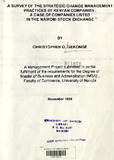| dc.description.abstract | The management of strategic change has gained tremendous attention in recent
years. The 1990's have seen extreme changes in the competitive forces in the
global and domestic markets. These changes have greatly affected the
management of businesses in Kenya. Therefore, effective strategic change
management has become essential for the survival of any company in Kenya.
The need for the study arose out of these recent turbulent and discontinuous
changes that the Kenyan economy has experienced and to determine what
Kenyan companies are doing in managing these changes in order to achieve
their strategic intents. The survey for the study reported here was conducted in
the months of September and October, 1999. The study's specific objectives
were to identify and document change management practices applied by the
Kenya companies; to identify and document the influencing factors in applying
these practices and to establish the strategic orientation of the change
management practices by Kenyan companies.
The sample was a census of all the 'Kenyan companies listed in the Nairobi
Stock Exchange. The researcher chose all ~ted companies in order to
determine the strategic change management practices and strategic orientation
in all the sectors of the Kenyan economy. These sectors are the agricultural,
industrial and allied, finance and investments and commercial and allied.
The data was collected using a structured questionnaire developed in line with
-the study objectives. The data was analyzed and presented using descriptive
statistics and factor analysis. 58.2 percent of the sampled companies
responded to the study. The results of the study reveal that the environmental uncertainty has made
Kenyan companies to realize the necessity of strategic planning and that the
Kenyan companies use common and traditional practices of planning and
managing change.
The study largely revealed that most Kenyan companies (81.3 percent) have not
changed their long term corporate objective of profitability in the last ten years.
The long term planning patterns revealed by the research indicate that the
Kenyan companies use time horizons of 3 to 5 years and make plans which are
explicit (93.9 percent) and that these plans (93.8 percent) involve products and
markets.
The study futher revealed that, few 9.4 percent) Kenyan companies do industry
and competitor analysis (9.4 percent) before formulating their strategies. Both
these activities are essential for strategically thinking companies before they
prepare their plans. This finding, therefore, places Kenyan companies between
phases I and II on Gluck, et ai, (1980), continuum of strategic development
evolution, whose characteristics are preparing functionally based plans, using
historical data, no leveraging of resoursec and the value system is to meet
budgetary targets.
A number of studied firms (24.0 percent) reported that they experienced greatest
change in competition, of which 33.4 percent experienced most change in this
area. This was followed by the products (17.3 percent) of the firms, and
technology and structure (15.4 percent) of the firms, each, respectively. The
findings further show that change initiation was largely done by CEO (59.4
percent), followed by senior management (20.0 percent), and the Board of Directors (19.0 percent), with the consultants making the least contribution to
the initiation of change (8.2 percent) .
The study also revealed that the top and middle level management were most
involved in managing strategic change, with 53.1 percent and 59.4 percent most
involvement, respectively. The consultants were least involved (37.5 percent).
The tools most used to involve employees during the strategic change process
were interdisciplinary task forces (49.9 percent), as well as brainstorming
sessions (34.4 percent). The research findings further revealed that the
processual approach in managing strategic change was used most (50.0
percent), followed by the incremental ch1nge approach (28.2 percent). These
approaches are usually associated with firms that are in the early phases of
adopting to the concept of strategic planning and operate in a stable
environment.
The findings also revealed that company objectives (71.9 percent) influenced the
strategic change process most. The managers played major roles in training
(53.2 percent), providing information to employees during change 71.9 percent)
and providing support to employees (53.2 percenQ during the strategic change
process, to enable them cope with the challenges of strategic change.
The results further revealed that the main challenges of managing change in
most Kenyan companies is resistance by employees to change, exhibited by
delays (37.5 percent), apathy (31.4 percent) and withdrawal (25.0 percent). At
the organizational level, increased union activities (41.7 percent), and
absenteeism (34.4 percent), were the main features of resistance. These
resistance features were viewed as reducing productivity in the organizations. A factor analysis involving 125 variables of 12 factors influencing the successful
implementation of the strategic change management programme was done. The
results revealed that the respondents consider culture and the management
team, in that order, as the most influential factors in implementing successful
management of strategic change in their companies. The least important factor
was considered to be attitude toward change.
This study was constrained by a non response by 23 companies (41.8 percent).
It was not possible, therefore, to determine the strategic orientation and the
strategic change practices used by these companies. The non-response was
largely due to an erroneous perception that the research findings could be used
by the competitors to gain undue advantage over the non respondents. (The
non-response could affect the reliability of results of the study. Time was also a
major limiting factor in terms of data collection and analysis
A more comprehensive research should be undertaken to determine the level of
strategic thinking, phase of strategic planning on the Gluck, et al, (1980)
framework, and the aggressiveness of matching internal conditions to external
characteristics by Kenyan companies. In conclusion, the study revealed that Kenyan firms use both the processual and
incremental models in managing strategic change and consider culture as the
most important factor that influences the successful implementation of strategic
change management. | en |

